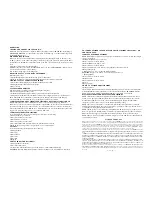
6150 OPERATING MANUAL
* 3-ONE TOUCH & 10 TWO TOUCH MEMORY
* VOLUME CONTROL
* LIGHTED KEYPAD
* COMPATIBLE WITH COMPUTER BANKING
* FULLY MODULAR CORDS INCLUDED
* HEARING AID COMPATIBLE
* DESKTOP AND WALL MOUNTABLE
6150**V0E21M
13 MEMORY TRENDLINE PHONE
THE FCC WANTS YOU TO KNOW
DESIGN COMPLIANCE
Your telephone is designed to comply with FCC Rules and Regulations, Part 68. It can be connected
to the telephone network as FCC-registered terminal equipment. The registration number is printed on the label on the bottom of your
telephone.
NOTIFICATION TO THE TELEPHONE COMPANY
As a customer of the local telephone company, you must, if they ask,
tell them before connecting your telephone to the telephone company lines. The telephone company may need the FCC registration number
and the ringer equivalence of the telephone. This information is printed on a label on the bottom of your telephone.
RINGER EQUIVALENCE
The ringer equivalence indicates the amount of power that your telephone draws from the telephone
company line during ringing. The number is printed on the label on the bottom of your telephone.
If you have more than one telephone (or other terminal device) connected to the telephone company line, you should total the
ringer equivalence numbers (REN’s), and be sure that the total is not more than five. Your telephones may not ring if the total is more than
five. Also, in some rural locations, your telephone may not ring if the REN total is more than three.
RESTRICTIONS
You must not connect your telephone to coin-operated lines or party lines.
INTERFERENCE POTENTIAL
If your telephone has a push-button dial, it may generate radio frequency energy. If not
properly used, it may interfere with radio and television reception. If the telephone does cause interference with reception, move the radio or
television to another electrical circuit or another location. If necessary, you may need to seek advice from an experienced technician.
INSTALLATION
This model telephone must be connected to the telephone company lines through a modular jack. The required
USOC for the modular jack is RJ11C for desk mounting and RJ11W for wall mounting. The USOC number is printed on the label on the
bottom of your telephone.
TYPE OF DIALING
If your telephone has a push-button TONE dial, you must have TONE service from your telephone
company to use your telephone for dialing. If your telephone has a rotary dial, you are not required to have TONE service. Note that you will
usually be charged extra for TONE service.
HEARING-AID COMPATIBILITY
The handset on your telephone will work with magnetically-coupled hearing aids. You can
use a hearing aid equipped with a T (Telephone) switch.
IN CASE OF TROUBLE
If your telephone should cause problems on the telephone line, the telephone company can temporarily
disconnect your service. The telephone company must then notify and allow you to correct the problem.
The telephone company may from time to time change its lines or equipment. They must notify you if planned changes will affect
your telephone service, to allow you to take steps to prevent interruptions.
This device complies with Part 15 of the FCC Rules. Operation is subject to the following two conditions: (1) this device may not cause
harmful interference, and (2) this device must accept any interference received, including interference that may cause undesired
operation.
Warning: Changes or modifications to this unit not expressly approved by the party responsible for compliance could void the user’s
authority to operate the equipment.
NOTE: This equipment has been tested and found to comply with the limits for a CLASS B digital device, pursuant to Part 15 of the
FCC Rules. These limits are designed to provide reasonable protection against harmful interference in a residential installation. This
equipment generates, uses, and can radiate radio frequency energy and, if not installed and used in accordance with the instructions, may
cause harmful interference to radio communications. However, there is no guarantee that interference will not occur in a particular
installation. If this equipment does cause harmful interference to radio or television reception, which can be determined by turning the
equipment off and on, the user is encouraged to try to correct the interference by one or more of the following measures:
-
Reorient or relocate the receiving antenna.
-
Increase the separation between the equipment and
receiver.
-
Connect the equipment into an outlet on a circuit different from that to which the receiver is connected.
-
Consult the dealer or an experienced radio TV technician for help.


